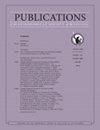Pushing the Limits of the Cosmic Origin Spectrograph (COS) with an Optimized Background Correction
IF 7.7
3区 物理与天体物理
Q2 ASTRONOMY & ASTROPHYSICS
Publications of the Astronomical Society of the Pacific
Pub Date : 2024-07-08
DOI:10.1088/1538-3873/ad57f6
引用次数: 0
Abstract
Observations utilizing the ultraviolet capabilities of the Cosmic Origin Spectrograph (COS) onboard the Hubble Space Telescope are of unique value to the astronomy community. Spectroscopy down to 900 Å with COS has enabled new science areas. However, contrary to the situation at longer wavelengths, these observations are limited by detector background noise. The background correction currently applied by the standard calibration pipeline (通过优化背景校正推动宇宙起源摄谱仪(COS)的极限发展
利用哈勃太空望远镜上的宇宙本源摄谱仪(COS)的紫外线功能进行的观测对天文学界具有独特的价值。利用 COS 进行低至 900 Å 的光谱测量开辟了新的科学领域。然而,与更长波长的情况相反,这些观测受到探测器背景噪声的限制。标准校准管道(CalCOS)目前应用的背景校正并没有针对暗目标进行优化,从而限制了低信噪比(S/N)观测的科学价值。在这项工作中,我们研究了 COS 远紫外探测器两个部分的暗率变化与时间、探测器高压(HV)和太阳活动的可能关系。通过分析,我们确定了一些探测器状态(以配置为基础,如高压和区段),这些状态描述了暗计数的空间分布,并创建了超暗计数,用于优化二维(2D)背景校正。我们开发并测试了另一种 COS 暗校正(ACDC),这是一种基于统计方法进行二维背景校正的专用管道,可生成经背景校正和通量校准的光谱。我们对 ACDC 的测试表明,其信噪比(S/N)值平均提高了 10%,在少数情况下,单个片段整个波长范围内的信噪比提高了 60%。
本文章由计算机程序翻译,如有差异,请以英文原文为准。
求助全文
约1分钟内获得全文
求助全文
来源期刊
CiteScore
6.70
自引率
5.70%
发文量
103
审稿时长
4-8 weeks
期刊介绍:
The Publications of the Astronomical Society of the Pacific (PASP), the technical journal of the Astronomical Society of the Pacific (ASP), has been published regularly since 1889, and is an integral part of the ASP''s mission to advance the science of astronomy and disseminate astronomical information. The journal provides an outlet for astronomical results of a scientific nature and serves to keep readers in touch with current astronomical research. It contains refereed research and instrumentation articles, invited and contributed reviews, tutorials, and dissertation summaries.

 求助内容:
求助内容: 应助结果提醒方式:
应助结果提醒方式:


